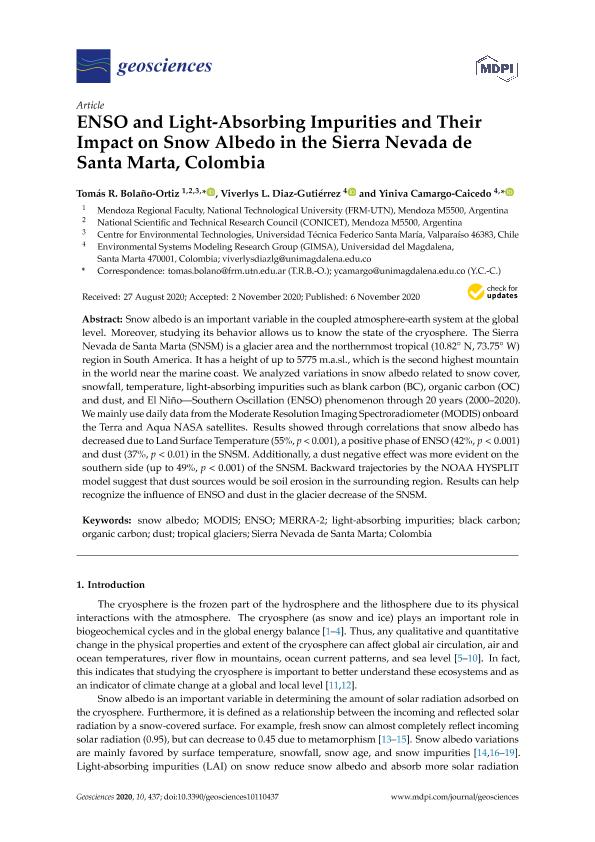Mostrar el registro sencillo del ítem
dc.contributor.author
Bolaño Ortiz, Tomas Rafael

dc.contributor.author
Diaz Gutiérrez, Viverlys L.
dc.contributor.author
Camargo Caicedo, Yiniva

dc.date.available
2021-10-21T16:09:04Z
dc.date.issued
2020-11
dc.identifier.citation
Bolaño Ortiz, Tomas Rafael; Diaz Gutiérrez, Viverlys L.; Camargo Caicedo, Yiniva; ENSO and light-absorbing impurities and their impact on snow albedo in the Sierra Nevada de Santa Marta, Colombia; Molecular Diversity Preservation International; Geosciences (Switzerland); 10; 11; 11-2020; 1-21
dc.identifier.issn
2076-3263
dc.identifier.uri
http://hdl.handle.net/11336/144643
dc.description.abstract
Snow albedo is an important variable in the coupled atmosphere-earth system at the global level. Moreover, studying its behavior allows us to know the state of the cryosphere. The Sierra Nevada de Santa Marta (SNSM) is a glacier area and the northernmost tropical (10.82◦ N, 73.75◦ W) region in South America. It has a height of up to 5775 m.a.sl., which is the second highest mountain in the world near the marine coast. We analyzed variations in snow albedo related to snow cover, snowfall, temperature, light-absorbing impurities such as blank carbon (BC), organic carbon (OC) and dust, and El Niño—Southern Oscillation (ENSO) phenomenon through 20 years (2000–2020). We mainly use daily data from the Moderate Resolution Imaging Spectroradiometer (MODIS) onboard the Terra and Aqua NASA satellites. Results showed through correlations that snow albedo has decreased due to Land Surface Temperature (55%, p < 0.001), a positive phase of ENSO (42%, p < 0.001) and dust (37%, p < 0.01) in the SNSM. Additionally, a dust negative effect was more evident on the southern side (up to 49%, p < 0.001) of the SNSM. Backward trajectories by the NOAA HYSPLIT model suggest that dust sources would be soil erosion in the surrounding region. Results can help recognize the influence of ENSO and dust in the glacier decrease of the SNSM.
dc.format
application/pdf
dc.language.iso
eng
dc.publisher
Molecular Diversity Preservation International

dc.rights
info:eu-repo/semantics/openAccess
dc.rights.uri
https://creativecommons.org/licenses/by-nc-sa/2.5/ar/
dc.subject
BLACK CARBON
dc.subject
COLOMBIA
dc.subject
DUST
dc.subject
ENSO
dc.subject
LIGHT-ABSORBING IMPURITIES
dc.subject
MERRA-2
dc.subject
MODIS
dc.subject
ORGANIC CARBON
dc.subject
SIERRA NEVADA DE SANTA MARTA
dc.subject
SNOW ALBEDO
dc.subject
TROPICAL GLACIERS
dc.subject.classification
Meteorología y Ciencias Atmosféricas

dc.subject.classification
Ciencias de la Tierra y relacionadas con el Medio Ambiente

dc.subject.classification
CIENCIAS NATURALES Y EXACTAS

dc.title
ENSO and light-absorbing impurities and their impact on snow albedo in the Sierra Nevada de Santa Marta, Colombia
dc.type
info:eu-repo/semantics/article
dc.type
info:ar-repo/semantics/artículo
dc.type
info:eu-repo/semantics/publishedVersion
dc.date.updated
2021-09-06T19:58:54Z
dc.journal.volume
10
dc.journal.number
11
dc.journal.pagination
1-21
dc.journal.pais
Suiza

dc.journal.ciudad
Basilea
dc.description.fil
Fil: Bolaño Ortiz, Tomas Rafael. Universidad Técnica Federico Santa María; Chile. Universidad Tecnológica Nacional; Argentina. Consejo Nacional de Investigaciones Científicas y Técnicas. Centro Científico Tecnológico Conicet - Mendoza; Argentina
dc.description.fil
Fil: Diaz Gutiérrez, Viverlys L.. Universidad del Magdalena; Colombia
dc.description.fil
Fil: Camargo Caicedo, Yiniva. Universidad del Magdalena; Colombia
dc.journal.title
Geosciences (Switzerland)
dc.relation.alternativeid
info:eu-repo/semantics/altIdentifier/doi/http://dx.doi.org/10.3390/geosciences10110437
Archivos asociados
